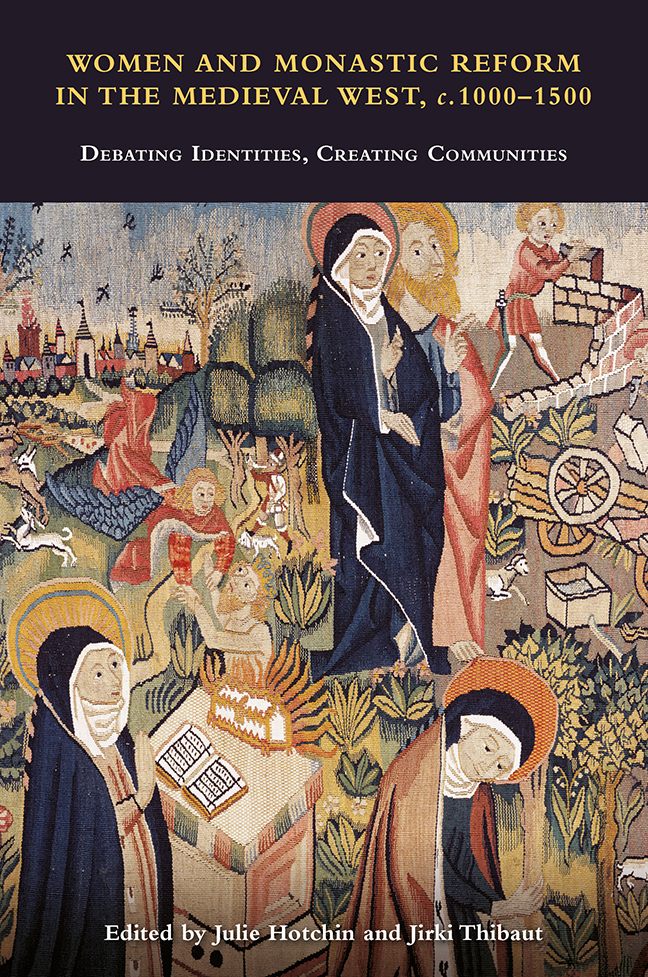 Women and Monastic Reform in the Medieval West, c.1000-1500
Women and Monastic Reform in the Medieval West, c.1000-1500 Book contents
- Frontmatter
- Dedication
- Contents
- List of Illustrations
- List of Contributors
- Acknowledgements
- List of Abbreviations
- 1 Debating Identities: Women and Monastic Reform in the Medieval West, c. 1000–1500
- 2 Liturgy and Female Monastic Hagiography Around the Year 1000: A lecture croisée of the Life of Liutrud, the Second Life of Glodesind of Metz and the So-called Pontificale Romano-Germanicum
- 3 Remakers of Reform: The Women Religious of Leominster and their Prayerbook
- 4 The Materiality of Female Religious Reform in Twelfth-Century Ireland: The Case of Co-located Religious Houses
- 5 Women as Witnesses: Picturing Gender and Spiritual Identity in a Twelfth-Century Embroidered Fragment from Northern Germany
- 6 Mulieres religiose and Cistercian Nuns in Northern Italy in the Thirteenth Century: A Choice of ‘Order’
- 7 Circulation of Books and Reform Ideas between Female Monasteries in Medieval Castile: From Twelfth-Century Cistercians to the Observant Reform
- 8 Women, Men and Local Monasticism in Late Medieval Bologna
- 9 Building Community: Material Concerns in the Fifteenth-Century Monastic Reform
- 10 Who Made Reform Visible? Male and Female Agency in Changing Visual Culture
- 11 Nuns, Cistercian Chant and Observant Reform in the Southern Low Countries
- Index
- Other volumes in Studies in the History of Medieval Religion
6 - Mulieres religiose and Cistercian Nuns in Northern Italy in the Thirteenth Century: A Choice of ‘Order’
- Frontmatter
- Dedication
- Contents
- List of Illustrations
- List of Contributors
- Acknowledgements
- List of Abbreviations
- 1 Debating Identities: Women and Monastic Reform in the Medieval West, c. 1000–1500
- 2 Liturgy and Female Monastic Hagiography Around the Year 1000: A lecture croisée of the Life of Liutrud, the Second Life of Glodesind of Metz and the So-called Pontificale Romano-Germanicum
- 3 Remakers of Reform: The Women Religious of Leominster and their Prayerbook
- 4 The Materiality of Female Religious Reform in Twelfth-Century Ireland: The Case of Co-located Religious Houses
- 5 Women as Witnesses: Picturing Gender and Spiritual Identity in a Twelfth-Century Embroidered Fragment from Northern Germany
- 6 Mulieres religiose and Cistercian Nuns in Northern Italy in the Thirteenth Century: A Choice of ‘Order’
- 7 Circulation of Books and Reform Ideas between Female Monasteries in Medieval Castile: From Twelfth-Century Cistercians to the Observant Reform
- 8 Women, Men and Local Monasticism in Late Medieval Bologna
- 9 Building Community: Material Concerns in the Fifteenth-Century Monastic Reform
- 10 Who Made Reform Visible? Male and Female Agency in Changing Visual Culture
- 11 Nuns, Cistercian Chant and Observant Reform in the Southern Low Countries
- Index
- Other volumes in Studies in the History of Medieval Religion
Summary
This chapter investigates the dynamics of institutional reform in northern Italy at the beginning of the thirteenth century. It focuses on how religious women influenced and shaped the processes of institutionalisation that affected their way of life. By examining two exemplary case studies from the northern region of Lombardy, I will explore how these mulieres religiose were gradually consolidated into monastic institutions through a long-term and negotiated process. Close attention to how these processes unfolded highlights how religious communities were shaped by their local social, religious and political circumstances. The roles of papal, episcopal and monastic authorities, local benefactors and stakeholders in the affected communities and, above all, the women themselves, are key to understanding the contingent processes through which mulieres religiose became Cistercian nuns.
The case studies in this chapter are from the northern Italian cities of Cremona and Pavia. The individual communities shared similar features, such as their location in an urban environment, strong local support and relation to episcopal authority, although the processes of institutionalisation unfolded along very different trajectories contingent upon specific local circumstances. This analysis allows us to examine the motives of various actors involved; it also gives an insight into how very different processes of institutional change nevertheless produced similar results in transforming the organisational structures of women's religious communities.
Religious Women and the Cistercian Order in Lombardy
Women's religious communities could be associated with the Cistercian Order in varying ways. Some female monasteries were officially incorporated into the Order by the General Chapter, although this juridical status did not necessarily guarantee the provision of spiritual care by the Cistercians. In contrast, many female communities were granted Cistercian privileges and the right to follow the Cistercian Institutiones by the pope, and were recognised as Cistercian by the Curia without any involvement by the General Chapter. Further, various monastic patrons, such as episcopal or secular founders, also favoured the Cistercian way of life and initiated processes to gain recognition and incorporation of their foundations with the General Chapter, as much as they could. The women concerned also endeavoured to live a religious life influenced by Cistercian ideals, adopting Cistercian customs and acquiring the benefits of their associated legal privileges, although they remained outside the formal structures of the General Chapter.
The links between female communities and the Cistercian Order were diverse, and the exact nature of this institutional relationship has been widely debated.
Information
- Type
- Chapter
- Information
- Women and Monastic Reform in the Medieval West, c.1000-1500Debating Identities, Creating Communities, pp. 132 - 153Publisher: Boydell & BrewerPrint publication year: 2023